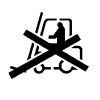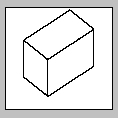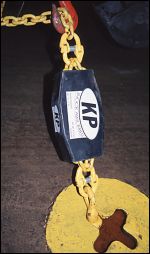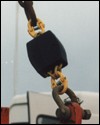| Machinery, machine parts | [German version] |
Table of contents |
|
| General: | ||
| Product information | ||
| Packaging | ||
| Transport | ||
| Container transport | ||
| Cargo securing | ||
Product information
Product name
| German | Maschinen, Maschinenteile |
| English | Machines, machinery, machine parts |
| French | Machines |
| Spanish | Máquinas |
| CN/HS number * | 84 ff. |
(* EU Combined Nomenclature/Harmonized System)
Product description
Machines convert one form of energy (steam, combustion, electricity) into other required forms of energy (e.g. generators) or convert the energy supplied into work, i.e. force machines comprising moving parts, such as control and operating elements, perform operations independently or provide assistance, so saving human or animal labor.
For the purposes of this product page, the term machinery denotes all relatively heavy and mechanically and electronically complex general cargo (packages).
Quality
Stringent requirements apply to the transport and storage of machinery. Since machinery is manufactured from a wide variety of materials, such as metals, with or without anticorrosion protection, plastics or ceramics, the consignor must check thoroughly prior to loading onto the intended means of transport that the machinery meets the requirements for safe transport.
High-quality and sensitive machinery should be subjected to continuous measurement/data recording of the stresses to which it is exposed during transport and storage, such as acceleration along the x, y, z axes, jolting (impact), temperature, pressure, moisture/humidity. Such measurement and recording tasks may be performed by independent devices which are firmly attached to the means of transport, the packaging or the product itself. Color indicators which are attached to the packaging and change color when predetermined temperatures, humidity values, tipping angles or impact stresses are exceeded, are another, although less effective, monitoring option.
Countries of origin
Machinery is today transported worldwide from and to all continents. This Table shows only a selection of the most important countries of origin and should not be thought of as exhaustive.
| Europe | Germany, Italy, Great Britain, France, Sweden |
| Africa | |
| Asia | Republic of Korea, Japan |
| America | USA, Canada |
| Australia |
Back to beginning
Packaging
Machinery may be protected by packaging containers, such as wooden boxes, crates, corrugated board and millboard structures.
Machinery is frequently transported in containers. In this case, the product is often not completely enclosed in a box. The protective functions of the lid and side walls of a box are then assumed by the containers. The box bottom, however, is still necessary so that the load may be distributed and the cargo properly secured.
The packaging container is, in principle, selected on the basis of its dimensions and weight and the impact, vibration and pressures to which it is exposed. The means and route of transport must also be taken into account. Wooden packaging is divided into the following types:
| load-bearing packages, in which slinging equipment, for example, is applied to the packaging. In this case, the base and lid of the packaging are in particular exposed to elevated compressive and flexural forces. Box lids should be designed to be capable of withstanding the load from further boxes stacked on top. The stacking crush pressure should be 1 metric ton/m2. For this purpose, the lid battens must rest on all sides on the upper battens of the side and end battens and the lid must rest on the edges of the sides and ends. Stringers to absorb the pressure during cargo handling with ropes or chains should also be placed inside the lid. The angle of spread of the slinging equipment should always be < 60°. The box base onto which the machinery or machine parts are attached by through-bolts or by a tight fit should be constructed such that rope slinging battens and, if present, forklift pockets are arranged symmetrically relative to the center of gravity. |
 Figure 1 |
 Figure 2 |
| accompanying packaging, in which a machine, for example, has its own lashing or slinging attachments by means of which it is handled. |
 Figure 3 |
When wooden packaging containers or cargo securing materials are used, it may, under certain circumstances, be necessary to comply with the quarantine regulations of the country of destination and a phytosanitary certificate may have to be enclosed with the shipping documents. Information may be obtained from the phytosanitary authorities of the countries concerned.
Extreme variations in temperature may occur during transport and thus bring about sweating within the package. Especially in the case of maritime transport, the elevated salt content of water and air causes corrosion on unprotected surfaces. Various temporary corrosion protection methods may be used to protect corrosion-sensitive machinery from such damage:
| Protective coating method: In this case the metal surfaces are isolated from moisture, salts or acids by water-based anticorrosion coatings, solvent-based anticorrosion coatings, dipping waxes or corrosion-protective oils. | |
| Desiccant method: So-called climate-controlled or sealed packages are produced using barrier films (e.g. aluminum multilayer films) and desiccants. In this case, the machinery is enclosed in barrier films impermeable to water vapor. Bags of desiccant (water vapor absorbents such as silica gel, aluminum silicate or alumina) are previously positioned in the upper part of the climate-controlled package, the purpose of these bags being to reduce humidity within the package and to maintain humidity at a certain level (< 40 – 50%). No hygroscopic materials should be enclosed in the sealed package. The humidity of the atmosphere within the package may be monitored by means of moisture indicators or recorders. | |
| VCI method (VCI = volatile corrosion inhibitor): The protective agent, borne on a substrate, passes into the gaseous state within the package, is deposited on the surface of the packaged article and forms a coating which provides protection against the ambient atmosphere. The VCI method should only be used for purely metallic articles. |
The article is secured in the package by bolting to the box base or by a tight fit with squared lumber, possibly together with vibration damping materials (rubber, plastics) or, for smaller articles, by cushioning. The safety clearance between the machine and box walls and internal battens should be at least 30 mm. Deformation of 30 mm readily occurs during cargo handling. A safety clearance of at least 50 mm should be maintained for sensitive machine parts and climate-controlled packages. It should furthermore be ensured that any cargo securing measures which penetrate the barrier film are resealed with suitable sealants.
Large machines are sometimes transported unboxed and undismantled, with only sensitive machine parts being protected against exposure to mechanical stresses and climatic conditions by films, cushioning materials and corrosion protection agents.
The following information about the machinery or machine parts should be available in order to produce a package:
| Precise name | |
| External dimensions (possibly enclosing drawings) | |
| Weight and center of gravity | |
| Lifting and lashing points indicating their strength | |
| Materials used (e.g. metals with or without corrosion protection, plastics, ceramic materials) | |
| Points of contact with the box base (possibly enclosing drawings) | |
| Transport and storage time (period of protection for temporary corrosion protection) | |
| Transport route and port of destination | |
| Type of transport, handling and storage | |
| Marking | |
| Possible use of recording devices to keep a record of the course of cargo movements |
Figures
(Click on the individual Figures to enlarge them.)
 Figure 4 |
 Figure 5 |
 Figure 6 |
 Figure 7 |
 Figure 8 |
 Figure 9 |
 Figure 10 |
 Figure 11 |
 Figure 12 |
 Figure 13 |
 Figure 14 |
 Figure 15 |
 Figure 16 |
 Figure 17 |
 Figure 18 |
 Figure 19 |
| Marking of packages | ||
 Sling here |
 Center of gravity |
 Keep dry |
 Top |
 Fragile |
 Do not use forklift truck here |
Back to beginning
Transport
Transport of a 200 metric ton diesel engine from Augsburg to Sanshui, China [Dresden Workshop 05/1996, „The unassessed risk“].
 Figure 20 |
 Figure 21 |
 Figure 22 |
 Figure 23 |
 Figure 24 |
 Figure 25 |
 Figure 26 |
 Figure 27 |
 Figure 28 |
Symbols
 General cargo |
Means of transport
Ships (e.g. general cargo, heavy cargo ships, roll-on/roll-off ships, container (ro-ro) ships), truck, railroad, aircraft.
Bulk carriers are suitable only if considerable effort is put into securing the cargo.
Container transport
Standard containers, open-top containers, hard-top containers, flatracks or platforms subject to compliance with limits for water content of packaging and container floor. Use of containers is also subject to the dimensions, weight and center of gravity of the cargo.
The weight of the cargo should be uniformly distributed over the container floor area, while complying with the maximum weight in accordance with the CSC (Container Safety Convention) approval. The maximum line load must also be taken into account when loading containers (Container loading capacity). If the packages are of different weights or the container cannot be fully loaded or the admissible total cargo weight is such that the container cannot be fully loaded, the container must be loaded such that the center of mass of the cargo is located approximately half way along the longitudinal axis of the container; in no event may more than 60% of the cargo weight be concentrated in one half of the container in the longitudinal direction. If it is not known when the container is loaded whether the container will be stowed lengthwise or crosswise once on board, containers should be fully stuffed in both their longitudinal and their transverse direction. If dead space between the cargo and the container cannot be avoided, this space must be filled by shoring (bracing) or with suitable materials, for example with cargo protection cushions, cushioning of various materials, boxes, paperboard, boards etc.. When air cushions are used, the correct inflation pressure must be maintained.
Machines or machine parts with an excessively small bearing area should be placed in the container on dunnage of boards or squared lumber in order to avoid subjecting the container floor to a point load. Either criss-cross dunnage should be laid in order to distribute the pressure over the largest possible area or squared lumber should be laid over the whole length of the container. The gap between the squared lumber and the side walls should be approx. 1/4 of the container’s width.
 Figure 51 |
In the case of transport on flatracks, care must be taken to ensure that machinery/machine parts are packaged such that they are not affected by contamination from containers stowed above or adjacent to them.
Cargo handling
Check and comply with slinging points, forklift pockets, total weight and center of gravity of the machine. The permissible loading capacity of the slinging or handling equipment (crossbar, chain or other slings in conjunction with self-balancing suspension tackle or slewing gear) and the lifting capacity of the lifting gear must also be taken into account. An appropriate crossbar must be supplied together with machines having an eccentric center of gravity.
 Figure 29 |
 Figure 30 |
Stowage factor
Highly variable, depending upon packaging, dimensions and weight, e.g.:
| Diesel engines 5.65 – 7.10 m3/t [14] | |
| Tractors 4.81 – 5.65 m3/t [14] | |
| Marine engines 2.26 – 2.83 m3/t [14] | |
| Agricultural machinery 1.39 – 2.23 m3/t [11] | |
| Machine parts 1.75 – 5.29 m3/t in solid wooden boxes [1] | |
| Combine harvester parts 2.28 m3/t without packaging [1] | |
| Crane parts 3.13 m3/t in solid wooden boxes [1] |
Stowage space requirements
For maritime transport, machinery should preferably be stowed below deck Heavy machines are placed on wooden supports in such a manner that the floor of the means of transport is not subjected to a point load. Maximum admissible deck, ‚tween deck and tank deck loading capacities must not be exceeded.
It should be noted that often only the base of packaging boxes for heavy machinery is strongly built, while the side walls are more lightly built. This must be taken into account when securing boxes with wooden blocking.
Machinery sensitive to jolting is best stowed amidships.
Segregation
Machine and shipping details should be shown on metal plates attached to the package. It is not advisable to use packing slips in plastic sleeves as they are easily destroyed and lost due to damage and moisture during transport and cargo handling.
Oil crayon, marker, black and indelible paint are relatively rarely used for segregation.
 Figure 31 |
Cargo securing
Comply with the consignor’s/manufacturer’s loading instructions in order to avoid damage due to mechanical stresses. It is possible to ensure by means of lashing plans that the cargo securing means are used in such a way that neither packaging nor machinery are damaged.
 Figure 32 |
Both the means of transport and the package or the machinery itself must be suitably equipped for correct stowage and lashing (lashings, lashing points, such as lashing rings and lashing pots and the like).
 Figure 33 |
Depending upon the number, sizes, centers of gravity and weights of the items of cargo, the principles of cargo securing could or should be combined (direct securing, e.g. tight fit or loop lashing, and frictional securing, e.g. tie-down lashing).
For further information see also the chapters entitled
| „Basic physical principles of cargo securing“, | |
| „Road vehicles, selection, equipping and loading capacity“, | |
| „Cargo securing materials“ and | |
| Machine components |
in the GDV Cargo Securing Manual.
Cargo securing examples:
Truck:
Securing the cargo directly with lashing chains or wire ropes with tighteners (e.g. turnbuckles or spindle clamps), steel strapping or lashing belts (e.g. lashing belts with ratchets) in order to avoid slippage and tipping.
 Figure 34 |
 Figure 35 |
Producing a tight fit using other cargo, the borders of the loading area or by shoring or bracing with wood.
Frictional securing by tying down with lashing belts (e.g. lashing belts with ratchets) in conjunction with nonslip mats in order to avoid slippage and tipping. Lashing chains, wire ropes and steel strapping have little elasticity and are thus unsuitable for tie-down lashing. Lashing chains with integral pretensioners are an exception (see Figure 36).
 |
 |
| Figure 36: Shock absorber [Safety-Harbor] |
|
Machinery sensitive to impact and vibration should be transported on trucks with air suspension.
Aircraft:
Cargo securing with lashing belts and nets on an air freight pallet (also known as a sheet metal pallet). The air freight pallet is then secured on the loading area in the aircraft using special securing devices. Machinery which cannot be adequately secured on air freight pallets is secured as a „floating“ cargo, i.e. the machine is not secured on the aircraft loading area solely by means of the air freight pallet, but is instead lashed directly to aircraft loading area.
 Figure 37 |
 Figure 38 |
Ship:
Deck loading: Machinery and machine parts are not generally loaded on deck as such cargoes are generally at risk of corrosion. However, if deck loading is nevertheless justified, the cargo should be secured directly with lashing chains or wire ropes with tighteners (e.g. turnbuckles or spindle clamps). If a tight fit is produced using other cargo, the borders of the loading area or by shoring or bracing with wood (lumber shoring), the cargo must additionally be secured against flotation by wire rope lashings passing over the top.
 Figure 39 |
Loading below deck: In a conventional ship or container, the cargo is directly secured with lashing chains or wire ropes with tighteners (e.g. turnbuckles or spindle clamps) or steel strapping in order to avoid slippage and tipping. A tight fit may be produced by using other cargo, the borders of the loading area or by shoring or bracing with wood (lumber shoring).
 Figure 40 |
 Figure 41 |
 Figure 42 |
 Figure 43 |
In the case of ro-ro ships, machinery is for the most part secured directly on roll trailers. The roll trailers are then in turn directly secured in the ship with lashing chains and wire ropes.
Railroad:
For railroad transport, the cargo should essentially be secured against horizontal jolting impacts (up to 4 times the weight of the cargo) during switching. Freight cars with high-performance buffers or as a block train reduce the impact forces and should be used for transporting machinery sensitive to impact and vibration.
Rigid loading: Securing the cargo directly with lashing chains or wire ropes with tighteners (e.g. turnbuckles or spindle clamps) or steel strapping in order to avoid slippage and tipping. A tight fit is produced using other cargo, the borders of the loading area or by shoring or bracing with wood (lumber bracing).
 Figure 44 |
 Figure 45 |
Sliding loading: The cargo should be attached to bevelled wooden sliders or sleds with through-bolts and is secured against crosswise displacement by lateral wooden guides. The minimum sliding path which must be available in the longitudinal direction of the freight car is 1.5 m. If this path is not available, friction-enhancing beds must be provided. Displacement of the cargo must not result in an excess axle load. If several switching impacts are to be expected during a transport operation, a sliding load is not suitable.
 Figure 46 |
Back to beginning
Risk factors and loss prevention
RF Temperature
Machinery requires particular humidity/moisture and possibly ventilation conditions (SC IV) (storage climate conditions).
| Designation | Temperature range | Source |
| Travel temperature 20°C | 5 – 30°C | [1] |
If the temperature falls below freezing, frost damage may occur, e.g. due to ice expansion at points where condensation, water drips and drainage water have collected; lubricating or insulating oils thicken, i.e. their viscosity falls (it is thus best to use oils with a low solidification point or multigrade oils). Conveyor belts or insulation may become brittle and break. Cooling water systems should be drained.
At elevated temperatures in the tropics, corrosion protection agents with a low dropping point (45 – 50°C) do not provide adequate protection.
Predetermined temperature ranges may be monitored by means of temperature indicators or recorders.
Back to beginning
RF Humidity/Moisture
Machinery requires particular humidity and possibly ventilation conditions (SC IV) (storage climate conditions).
| Designation | Humidity/water content | Source |
| Relative humidity | 60 – 65%. Corrosion, which proceeds rapidly from 60%, must be prevented on at risk components by suitable measures. | [1] |
| Climate-controlled/sealed packaging | <40 – 50% | GDV |
| Water content | No water content. Lumber used for packaging should have a maximum content of 12 – 18%. | [1] |
| Maximum equilibrium moisture content | 65% | [1] |
Machinery is a cargo which is at risk of corrosion. Corrosion losses are in particular caused by
| Seawater and seasalt aerosols | ||
| during maritime transport due to leaky containers or hatches | ||
| during storage at sea ports near water | ||
| Rain water: | ||
| when containers are damaged | ||
| uncovered railroad freight cars and trucks | ||
| incorrect storage in the open | ||
| use of unsuitable tarpaulins | ||
| exposed loading in wet weather conditions | ||
| Condensation water: | ||
| on the means of transport | ||
| on the cargo/load | ||
| within the packaging | ||
| Accompanying chemical cargo | ||
| Residues of chemicals from previous cargoes, possibly combined with moisture | ||
| Hygroscopic accompanying cargo (e.g. fresh lumber) | ||
| Relative humidities > 40% | ||
Corrosion of, for example, steel begins at a relative humidity of 40% and rapidly accelerates at relative humidity levels of > 60%:
 Figure 47 |
A distinction may be drawn between various Types of corrosion .
There are two main causes of corrosion:
| Pure oxidation and | |
| electrochemical decomposition of the metal due to the presence of an electrolyte (e.g. salts, acids, bases). |
Pure oxidation means combination of the ferrous metal with atmospheric oxygen. Oxidation is assisted by electrochemical (electrolytic) processes. The extent of electrolytic decomposition is determined by the conductivity of the electrolyte present. For example, salt water is more conductive than fresh water and therefore has a greater corrosive effect. The effect of sulfurous acid is even more extreme.
If corrosion damage is suspected, testing is, for example, performed using the silver nitrate method, to find out whether chloride solutions or fresh water are the cause. When determining the origin of the sea salt on the cargo surface (corrosion resulting from contact with seawater or spray deposition by the hold/container air), the damaged surface is assessed with a magnifying glass (30x magnification): cubic sodium chloride (NaCl) crystals of an edge length of approx. 1/5 mm indicate contact with seawater. In the case of spray deposition, no crystal structures may be observed, since the crystals are too small (1/100 mm).
Corrosion may be avoided by using suitable corrosion protection methods. It is frequently the case that the manufacturer has used excessively wet wood for boxes, as a result of which corrosion may start from this point onwards. Softwood (e.g. spruce, pine, larch) also releases moisture and thus promotes corrosion. Damage of this type may easily be mistaken for normal wetness damage.
 Figure 52 |
 Figure 53 |
The value of steel products is in particular reduced by the effects of corrosion. The degree of rusting is assessed on the following scale:
| R0 | No rust |
| R1 | 0.5 – 1% rust coverage |
| R2 | approx. 5% rust coverage |
| R3 | approx. 15% rust coverage |
| R4 | 30 – 40% rust coverage |
| R5 | > 50% rust coverage |
The humidity of the atmosphere within a package may be monitored by means of moisture indicators or recorders.
Back to beginning
RF Ventilation
Machinery requires particular humidity/moisture and possibly ventilation conditions (SC IV) (storage climate conditions).
Back to beginning
RF Biotic activity
This risk factor has no significant influence on the transport of this product.
Back to beginning
RF Gases
Sulfur dioxide (SO2) and sulfur trioxide (SO3) have a corrosion-promoting action if these gases are dissolved in mist droplets; combined with water, they form sulfurous acid (H2SO3) or sulfuric acid (H2SO4). Sulfur dioxides are produced by the combustion of fossil fuels, ore smelting, bleaching of foodstuffs and textiles and insect fumigants. It is essential to prevent any contact with sulfur and its gases. Cargo holds should accordingly be cleaned prior to loading.
Back to beginning
RF Self-heating / Spontaneous combustion
This risk factor has no significant influence on the transport of this product.
Back to beginning
RF Odor
This risk factor has no significant influence on the transport of this product.
Back to beginning
RF Contamination
| Active behavior | Leakages of lubricants which had a solid consistency at lower temperature ranges may occur. Corrosion may result in contamination of other goods or articles in the package with rust particles. |
| Passive behavior | Dust from coal, ores, salts and especially fertilizers and other bulk materials has a corrosive effect. For this reason, the holds and containers have accordingly to be washed clean, to remove any residues from previous cargoes. When washing out ship holds with seawater, it must be borne in mind that seawater also contains salts which would encourage corrosion later in the voyage. It is therefore best to use fresh water for cleaning purposes. The product should also be protected from acids, aggressive gases (sulfur dioxide) and readily decomposing chemicals, as these also accelerate corrosion. In the case of transport on flatracks, care must be taken to ensure that machinery cannot be contaminated by containers stowed above or adjacent to them. |
Back to beginning
RF Mechanical influences
In order to avoid damage to machinery or machine parts or their packaging by mechanical stresses, it is essential that stowing, cushioning, bracing, lashing and securing within the package and on the means of transport are performed carefully and in accordance with instructions. Suitable slinging and cargo handling equipment and lifting gear must be selected and used on the basis of the cargo’s weight, center of gravity, slinging points and sensitivity to impact and vibration.
The use of vibration, impact and tipping indicators or recorders provides information about any excessive mechanical stresses to which the cargo may have been subjected.
 Figure 48 |
 Figure 49 |
 Figure 50 |
Back to beginning
RF Toxicity / Hazards to health
This risk factor has no significant influence on the transport of this product.
Back to beginning
RF Shrinkage / Shortage / Theft
Depending upon the desirability of the product, either entire machines, including the means of transport, or only part of the consignment is/are taken. Special recorders which date stamp the opening and closing of packages may prevent theft.
Back to beginning
RF Insect infestation
Machinery is not generally subject to insect infestation; however, in their search for new, dry breeding-grounds, insects (e.g. beetles and larvae) penetrate and destroy the packaging (risk of corrosion, contamination). Termites, for example, can even eat their way through plastic films. Such cargo should thus be stowed in absolutely pest-free holds or containers and not close to foodstuffs and animal feed.
When wooden packaging containers or cargo securing materials are used, it may, under certain circumstances, be necessary to comply with the quarantine regulations of the country of destination and a phytosanitary certificate may have to be enclosed with the shipping documents. Information may be obtained from the phytosanitary authorities of the countries concerned.
Back to beginning
